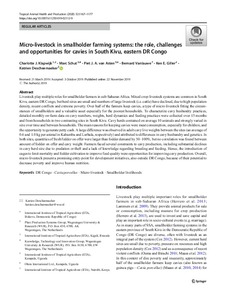| dc.contributor.author | Klapwijk, C.J. |
| dc.contributor.author | Schut, M. |
| dc.contributor.author | van Asten, P.J. |
| dc.contributor.author | Vanlauwe, B. |
| dc.contributor.author | Giller, K.E. |
| dc.contributor.author | Descheemaeker, K. |
| dc.date.accessioned | 2020-08-05T07:49:15Z |
| dc.date.available | 2020-08-05T07:49:15Z |
| dc.date.issued | 2020 |
| dc.identifier.citation | Klapwijk, C.J., Schut, M., van Asten, P.J., Vanlauwe, B., Giller, K.E. & Descheemaeker, K. (2019). Micro-livestock in smallholder farming systems: the role, challenges and opportunities for cavies in South Kivu, eastern DR Congo. Tropical Animal Health and Production, 52, 1167–1177. |
| dc.identifier.issn | 0049-4747 |
| dc.identifier.uri | https://hdl.handle.net/20.500.12478/6905 |
| dc.description.abstract | Livestock play multiple roles for smallholder farmers in sub-Saharan Africa. Mixed crop-livestock systems are common in South Kivu, eastern DR Congo, but herd sizes are small and numbers of large livestock (i.e. cattle) have declined, due to high population density, recent conflicts and extreme poverty. Over half of the farmers keep cavies, a type of micro-livestock fitting the circumstances of smallholders and a valuable asset especially for the poorest households. To characterize cavy husbandry practices, detailed monthly on-farm data on cavy numbers, weights, herd dynamics and feeding practices were collected over 15 months and from households in two contrasting sites in South Kivu. Cavy herds contained on average 10 animals and strongly varied in size over time and between households. The main reasons for keeping cavies were meat consumption, especially for children, and the opportunity to generate petty cash. A large difference was observed in adult cavy live weights between the sites (an average of 0.6 and 1.0 kg per animal in Kabamba and Lurhala, respectively) and attributed to differences in cavy husbandry and genetics. In both sites, quantities of fresh fodder on offer were larger than fodder demand by 50–100%, but no correlation was found between amount of fodder on offer and cavy weight. Farmers faced several constraints to cavy production, including substantial declines in cavy herd size due to predation or theft and a lack of knowledge regarding breeding and feeding. Hence, the introduction of cages to limit mortality and fodder cultivation to improve feed quality were opportunities for improving cavy production. Overall, micro-livestock present a promising entry-point for development initiatives, also outside DR Congo, because of their potential to decrease poverty and improve human nutrition. |
| dc.description.sponsorship | Directorate-General for Development Cooperation and Humanitarian Aid, Belgium |
| dc.format.extent | 1167-1177 |
| dc.language.iso | en |
| dc.subject | Democratic Republic of the Congo |
| dc.subject | Cavia |
| dc.subject | Livestock |
| dc.subject | Smallholders |
| dc.subject | Farmers |
| dc.subject | Livelihoods |
| dc.subject | Farming Systems |
| dc.subject | Fodder Crops |
| dc.title | Micro-livestock in smallholder farming systems: the role, challenges and opportunities for cavies in South Kivu, eastern DR Congo |
| dc.type | Journal Article |
| cg.contributor.crp | Maize |
| cg.contributor.crp | Roots, Tubers and Bananas |
| cg.contributor.affiliation | International Institute of Tropical Agriculture |
| cg.contributor.affiliation | Wageningen University and Research Centre |
| cg.contributor.affiliation | Olam International Ltd., Uganda |
| cg.coverage.region | Africa |
| cg.coverage.region | Central Africa |
| cg.coverage.country | Democratic Republic of the Congo |
| cg.coverage.hub | Central Africa Hub |
| cg.researchtheme | Natural Resource Management |
| cg.researchtheme | Social Science and Agribusiness |
| cg.identifier.bibtexciteid | KLAPWIJK:2020 |
| cg.isijournal | ISI Journal |
| cg.authorship.types | CGIAR and advanced research institute |
| cg.iitasubject | Agronomy |
| cg.iitasubject | Crop Husbandry |
| cg.iitasubject | Crop Systems |
| cg.iitasubject | Domestic Trade |
| cg.iitasubject | Farm Management |
| cg.iitasubject | Farming Systems |
| cg.iitasubject | Livelihoods |
| cg.iitasubject | Smallholder Farmers |
| cg.journal | Tropical Animal Health and Production |
| cg.notes | Open Access Article; Published online: 22 Nov 2019 |
| cg.accessibilitystatus | Open Access |
| cg.reviewstatus | Peer Review |
| cg.usagerightslicense | Creative Commons Attribution 4.0 (CC BY 0.0) |
| cg.targetaudience | Scientists |
| cg.identifier.doi | https://dx.doi.org/10.1007/s11250-019-02112-9 |
| cg.iitaauthor.identifier | Marc Schut: 0000-0002-3361-4581 |
| cg.iitaauthor.identifier | Piet van Asten: 0000-0003-0584-3552 |
| cg.iitaauthor.identifier | bernard vanlauwe: 0000-0001-6016-6027 |
| cg.iitaauthor.identifier | Ken E Giller: 0000-0002-5998-4652 |

